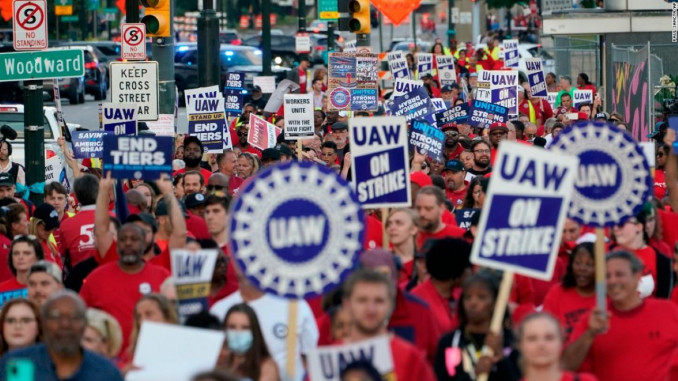
Going into the third week of the strike, last Friday, UAW (United Auto Workers) union president, Shawn Fain, called on another 7000 workers at two assembly plants to strike. The workers at the Chicago Ford plant build the Ford Explorer, Police Interceptor Utility and Lincoln Aviator and the GM plant in Lansing, MI builds mid-size SUVs. Now 25,000 of the 146,000+ auto workers in the UAW are on strike.
Fain said there has been “movement” by Stellantis, so no new strike against their plants. The strategy of the “Standup” strike, where certain plants are targeted is supposed to use the element of surprise strikes to force the auto companies to negotiate.
The strike is having some impact on the auto companies. But the union officials say they aren’t really negotiating. The companies are also pushing back, laying off workers where production isn’t needed because of the strike. In some plants workers have organized to refuse overtime to slow production and some bosses have threatened to discipline or fire them. At some striking plants, scabs and supervisors have been brought in to do some of the work. And at a few, workers have been hit by cars driven by scabs.
The politicians took advantage of the publicity of the strike. Biden was invited by Fain to make an appearance at a striking GM parts distribution plant outside of Detroit. And the next day Trump staged his rally inside a non-union parts plant, outside of Detroit. These politicians’ photo ops are about their election campaigns, not anything about what workers need.
It is difficult to predict the outcome of this strike. But, like other recent contract negotiations, the impact has gone beyond the question of dollars and cents. Fain has spoken about the class war that has been waged against auto workers and other workers. The incredible profits of the “Big 3” automakers – $250 billion in the past decade and close to $21 billion in the first 6 months of this year – have come at the expense of the lives and livelihoods of auto workers.
Like most workers, their wages have been falling way behind the rate of inflation. A tier system which hires new workers at $17 an hour keeps workers in a temporary status for years. And the only way workers can take home a paycheck that amounts to anything is to give up their lives to overtime, which also creates serious health and safety hazards. Auto workers, who years ago were among the better paid workers in the U.S., can now earn less than a worker at McDonalds.
The demands of this strike raise questions beyond the so-called “bread and butter” issues. The question of more paid time off to be with families – a shorter work week, with 32 hours of work for 40 hours pay is a challenge to the hyper-exploitation of workers in the plants. It would allow workers to spend less time producing profits for the corporations and more time for what they choose. It would also create more jobs.
The strike has also raised the question of the right to a job. The future of many auto workers is uncertain with the conversion to EVs (Electric Vehicles), which require fewer workers to assemble. The new battery plants are joint ventures with Chinese and South Korean companies. Will these plants be unionized?
The strike has also opened a wider discussion of the power of the working class and the need for workers to be involved in fighting for what they need, and the importance of real solidarity across the working class.
The strategy of “surprise” strikes means that the strikes have been organized in a top-down fashion. This has left many workers with little to do but wait and see if their plant will be called on to join the strike and question whether this strike is really using the power the workers could mobilize. Still, many auto workers are enthusiastic about the strike and at non-striking plants have been involved in “practice pickets” at their plants.
There is a lot we can learn from this strike – without a fight workers will continue to surrender our future to the billionaire class which will take as much as it can from us. A fight doesn’t mean a bargaining team, negotiating in secret and occasionally banging fists on the table. It means workers having a real say over what the demands are, organizing our forces and taking our fight to other workplaces and to the broader public. It means getting ready and organizing ahead and not waiting for contracts to expire. We can’t afford to sit back and wait and hope for the best.

